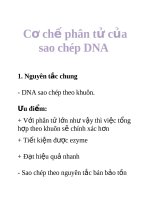Cơ chế phân tử của rối loạn tăng sinh tủy
Bạn đang xem bản rút gọn của tài liệu. Xem và tải ngay bản đầy đủ của tài liệu tại đây (1.75 MB, 30 trang )
CƠ CHẾ PHÂN TỬ CỦA
RỐI LOẠN TĂNG SINH TỦY
TS.BS Phan Thị Xinh
Bộ Môn Huyết Học
Đại Học Y Dược TP HCM
BIỆT HÓA TẾ BÀO HỆ TẠO MÁU
MYELOPROLIFERATIVE NEOPLASMS
(WHO CLASSIFICATION - 2008 )
Myeloproliferative disorders/neoplasms (MPD/MPN) are chronic
malignant conditions characterized by the clonal expansion of
hematopoietic cells from one or more myeloid lineages.
4
(Spivak JL, Ann Intern Med 2010)
BẤT THƯỜNG PHÂN TỬ TRONG CÁC RỐI
LOẠN TĂNG SINH TỦY
BỆNH LÝ BẤT THƯỜNG PHÂN TỬ
CLASSIFICATION OF THE MYELOPROLIFERATIVE DISORDERS ON THE
BASIS OF MOLECULAR PATHOGENETIC CHARACTERISTICS
6
ETV6
(TEL)
JAK2
PDGFRB
ABL
FGFR1
BCR
RAB5
H4
HIP1 CEP110
ZNF198
FOP
t(9;12)
t(9;22)
t(9;12)
t(9;22)
t(8;22)
t(6;8)
t(8;13)
t(8;9)
t(5;12)
t(5;17)
t(5;10)
t(5;7)
der(9)
ABL/BCR gene
ABL/BCR mRNA
No.9
ABL gene
6.0 kb
7.0 kb
Họat tính
tyrosine kinase (-)
P145
ABL
No.22
BCR gene
t(9;22)(q34;q11)
Sinh học phân tử của t(9;22)(q34;q11)
der(22)
Ph chromosome
ABL gene
BCR gene
9q34:
22q11:
8.5 kb BCR/ABL mRNA
BCR/ABL gene
P210
BCR/ABL
Họat tính
tyrosine kinase (+++)
9
b2 b3 a2e1
b2
a2e1
a2
e1
e1a2 :
b3a2 :
b2a2 :
198bp
287bp
212bp
1a1b
a2 a3
ABL
gene
(9q34)
intron 1
intron 2
# splicing exons
a11
#
##
Major BCR/ABL mRNA
Minor BCR/ABL mRNA
1
2
3
b1
b5
a2e1 e19b2
e19a2
4
minor BCR
major BCR
b2 b3e1 c1 c2 c3 c4 c5 c6 c7b1 b4 b5
BCR
gene
(22q11)
micro
BCR
e17 18 19 20 21 22 23e12 13 14 15 16
1
3
4
2
Những tổ hợp gen BCR/ABL
thường gặp trong CML
Tel
Cent
10
t(9;22)(q34;q11)
9q+
22q-
NST Ph
11
BCR probe
≈ 300 kb
ABL probe
≈ 650 kb
Vysis LSI BCR/ABL ES Dual Color Translocation probes
ASS gene-56kb
12
Vysis LSI BCR/ABL Dual Color,
Dual fusion translocation probes
Phân loại Tiêu chuẩn
Đáp ứng hoàn toàn về huyết học Huyết đồ về bình thường
Đáp ứng tối thiểu về di truyền tế
bào
66–95% Ph
+
Đáp ứng thấp về DTTB 36–65% Ph
+
Đáp ứng một phần về DTTB 1–35% Ph
+
Đáp ứng hoàn toàn về DTTB 0% Ph
+
Đáp ứng cao về DTTB 0–35% Ph
+
Đáp ứng cao về mặt phân tử Giảm ≥3-log bản sao BCR/ABL
Đáp ứng hoàn toàn về mặt phân tử Âm tính với RT-PCR
RT-PCR: reverse-transcription polymerase chain reaction
ĐÁNH GIÁ ĐiỀU TRỊ
CƠ CHẾ HOẠT ĐỘNG CỦA IMATINIB
MYELOID PROGENITORS.
STAT5 pathway, JAK2 is activated by autophosphorylation upon the association of receptors and
their ligands. The active JAK2 further phosphorylates the STAT5, which is translocated into the
nucleus to activate its target genes. Alternatively, the active JAK2 enters into the nucleus to
phosphorylate histone H3 at tyrosine 41 (H3Y41). H3Y41 phosphorylation disrupts the association of
HP1a with chromatin, which leads to the activation of oncogenes such as lmo2
Model depicting the decrease in HP1α binding to chromatin after
phosphorylation of H3Y41 by JAK2. On the left are the known functions
of HP1α; on the right are the known consequences of dysregulated
JAK2 seen as a feature in JAK2-mediated haematological malignancies.
JAK2 PHOSPHORYLATES HISTONE H3Y41 AND EXCLUDES
HP1α FROM CHROMATIN
Involvement of the cytokine receptor-tyrosine kinase axis in MPN oncogenesis. The four main myeloid growth
factor receptors involved in MPN pathogenesis are represented with their schematic principal downstream signaling
involving the binding of JAK2, and the phosphorylation of phosphatidyl-inositol-3-kinase (PI3K), the protein kinase
B (AKT), the signal transducers and activators of transcription (STAT), and the mitogen-activated protein kinases
(MAPK) (red arrows and brackets). The adaptor and E3 ubiquitinligase C-CBL down-regulates c-KIT and JAK2
signaling (blue bars). Red stars indicate the oncogenic mutations that occur in MPN resulting in a constitutive or
enhanced downstream signaling (red) with modulation of transcription and protein levels for cell cycle,
proliferation, and apoptosis-related factors. VF, JAK2V617F; Ex12, JAK2 exon 12 mutations; 505 and 515,
MPLW515 and MPLS505N mutations, D816V, KITD816V. Several point mutations have been described in C-CBL,
resulting in both loss of inhibitory functions (red crosses) and gain of function properties (red arrow)
Mutations in myeloproliferative neoplasms. Genes involved in MPN pathogenesis are linearly represented with their
principal functional or conserved domains. Molecular defects are shown in red. Point mutations are indicated by
vertical arrows, with horizontal bars spanning the domains where multiple mutations have been identified. Horizontal
arrows indicate truncating mutations that may occur anywhere in the downstream coding sequence. SH Src
homology, JH JAK homology, Ig immunoglobulin, TK tyrosine kinase, Pro proline, ASXN and ASXM ASX
conserved domains, NR nuclear receptor, PHD plant homeodomain
A model for molecular pathogenesis of MPN. The myeloid malignancy is initiated by a polyclonal or clonal
premalignant hematopoiesis, depending on the presence of germline or somatic molecular predispositions or
defects. Genes whose mutations trigger an overt MPN are indicated. The accumulation of additional events
participates in the progression of the disease, which ends with transformation to AML. Left and right vertical arrows
indicate that the transformation can occur in cells devoid of the specific MPN oncogenic mutations









